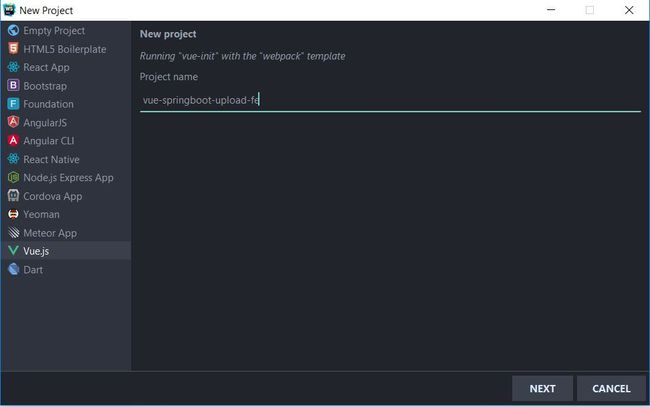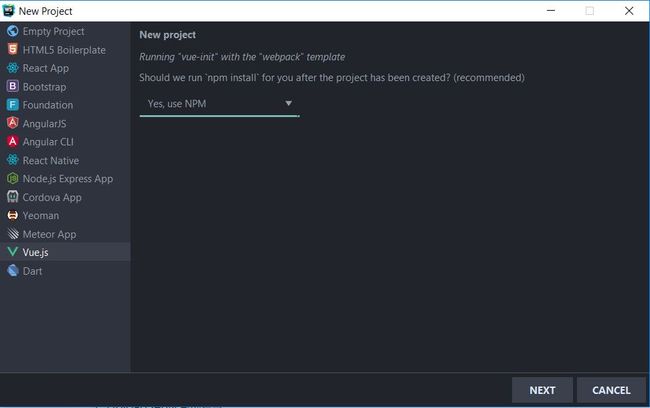写在最前
在上期教程中我们介绍了读写Excel与使用Selenium的入门方法,本期将介绍通过Vue+Spring Boot实现在WebApp中上传Excel导入测试脚本的功能。使用前后端分离的技术是因为这样便于后续功能的迭代,在本文中我们只涉及一个简单的前端界面及一个简单的后台服务。
运行结果展示与源码地址在文末,上期传送门:Java自动化——使用Selenium+POI实现Excel自动化批量查单词
步骤一览
- 使用Vue-Cli创建前端项目
- Navbar编写
- 脚本表格编写
- 使用Spring Initializr创建后端项目
- pojo类的编写
- UploadController的编写
- UploadService的编写
- 搭建简单的RESTful API
- 运行服务,编写脚本并上传
现在开始
-
使用Vue-Cli创建前端项目
运用vue-cli工具可以很轻松地构建前端项目,当然,使用WebStorm来构建会更加简洁(如图)。本文推荐使用WebStorm,因为在后续开发中,IDE会使我们的开发更加简洁。部分配置如图:
-
Navbar编写
作为一个WebApp,Navbar作为应用的导航栏是必不可少的。在本项目中,笔者引入了bootstrap对Navbar进行了轻松地构建。在vue中我们需要在components文件夹中将我们的组件加进去,对于本工程来说,Navbar是我们要加入的第一个组件,他独立于router之外,一直固定在网页上方。
2.1 首先,我们使用npm来安装vue,vue-cli,bootstrap
npm install vue npm install -g vue-cli npm install --save bootstrap jquery popper.js2.2 接下来我们在components目录下new一个vue组件,并且在main.js中引入bootstrap依赖:
import 'bootstrap/dist/css/bootstrap.min.css' import 'bootstrap/dist/js/bootstrap.min'2.3 下面就可以开始写代码了,由于本文只关注table相关的功能,所以导航栏中除了Script意外的元素都已经disable,代码如下:
2.3 在App.vue中引入MyNavbar
-
Script Table编写
作为自动化工具,必不可少的一部分就是引入Script,我们希望用户能够自由地使用H5界面进行Script的编写,因此在这里使用了vue的数据双向绑定进行Table CRUD。
3.1 新建一个vue组件ScriptTable,代码如下:
3.3 运行dev,打开localhost:8080
npm run dev
前端页面效果如下:
至此,本文相关的纯前端部分完成地差不多了,加上mock的数据后,我们可以开始进行后端的开发了。
-
使用Spring Initializr创建后端项目
为了更轻松地构建工程,构建RESTful API以及更轻松地配置请求处理,笔者选择了Spring Boot作为后端框架。
4.1 首先我们使用IDEA集成的Spring Initializr来构建项目,部分配置如图:
4.2 接下来在pom.xml中引入poi依赖,点击import change。如下所示:
org.apache.poi
poi-ooxml
4.0.0
4.3 接下来我们在application.properties中配置server.port=8088,与前端项目分开
-
pojo类Step的编写
下面是对pojo类的编写,本文所需的pojo只有Step一种,与前端的table相对应,代码如下:
import lombok.Data;
@Data
public class Step {
private String platform;
private String action;
private String path;
private String value;
private int wait;
private String screenshot;
}
-
UploadController的编写
接下来是对前端Post请求的Handler(Controller)进行编写,我们将上传这个Post请求与"/uploadfile"相对应,注意加入@CrossOrigin注解实现跨域,代码如下:
package com.daniel.vuespringbootuploadbe;
import org.springframework.beans.factory.annotation.Autowired;
import org.springframework.stereotype.Controller;
import org.springframework.web.bind.annotation.CrossOrigin;
import org.springframework.web.bind.annotation.PostMapping;
import org.springframework.web.bind.annotation.ResponseBody;
import org.springframework.web.multipart.MultipartFile;
import java.io.File;
import java.io.IOException;
import java.nio.file.Files;
import java.nio.file.Path;
import java.nio.file.Paths;
import java.util.List;
@Controller
@CrossOrigin
@ResponseBody
public class UploadController {
private static String UPLOADED_FOLDER = "src/main/resources/static/temp/";
@Autowired
private LoadService loadService;
@PostMapping("/upload")
public List singleFileUpload(MultipartFile file) {
try {
// Get the file and save it somewhere
byte[] bytes = file.getBytes();
Path path = Paths.get(UPLOADED_FOLDER + file.getOriginalFilename());
Files.write(path, bytes);
} catch (IOException e) {
e.printStackTrace();
}
// Print file data to html
List result = loadService.castToStep(new File(UPLOADED_FOLDER + file.getOriginalFilename()));
return result;
}
}
-
LoadService的编写
下面该编写Service来读取请求中传送的文件了,简单地来说只有一个步骤,将Excel中的Script转换为pojo的链表并在Controller中作为ResponseBody返回.
7.1 首先创建Service接口,代码如下:
package com.daniel.vuespringbootuploadbe;
import org.springframework.stereotype.Service;
import java.io.File;
import java.util.List;
@Service
public interface LoadService {
List castToStep(File file);
}
7.2 接下来创建Service实现类,代码如下:
package com.daniel.vuespringbootuploadbe;
import org.apache.poi.openxml4j.exceptions.InvalidFormatException;
import org.apache.poi.ss.usermodel.Row;
import org.apache.poi.ss.usermodel.Sheet;
import org.apache.poi.ss.usermodel.Workbook;
import org.apache.poi.xssf.usermodel.XSSFWorkbook;
import org.springframework.stereotype.Service;
import java.io.File;
import java.io.IOException;
import java.util.ArrayList;
import java.util.List;
@Service
public class LoadServiceImpl implements LoadService {
@Override
public List castToStep(File file) {
List steps = new ArrayList<>();
Workbook workbook = null;
try {
workbook = new XSSFWorkbook(file);
} catch (IOException e) {
e.printStackTrace();
} catch (InvalidFormatException e) {
e.printStackTrace();
}
Sheet sheet = workbook.getSheetAt(0);
int num = sheet.getLastRowNum() - sheet.getFirstRowNum();
//Read steps
for (int i = 0; i < num; i++) {
Row row = sheet.getRow(i+1);
Step step = new Step();
step.setPlatform(row.getCell(0).getStringCellValue());
step.setAction(row.getCell(1).getStringCellValue());
step.setPath(row.getCell(2).getStringCellValue());
step.setValue(row.getCell(3).getStringCellValue());
step.setWait((int) row.getCell(4).getNumericCellValue());
step.setScreenshot(row.getCell(5).getStringCellValue());
steps.add(step);
}
try {
workbook.close();
} catch (IOException e) {
e.printStackTrace();
}
return steps;
}
}
-
搭建简单的RESTful API
文章临近尾声,现在前后端的独立代码基本开发完毕,是时候搭建RESTful了,本文中的API非常简单,就是对上传做出响应,并将返回的json写入界面上的Table中,完成Script导入,npm安装axios后,在ScriptTable组件中加入如下代码:
getFile: function (event) {
this.file = event.target.files[0];
console.log(this.file);
},
submit: function (event) {
event.preventDefault();
let formData = new FormData();
formData.append("file", this.file);
axios.post('http://localhost:8088/upload', formData)
.then(function (response) {
for (let i = 0; i < response.data.length; i++) {
var tempData = {
platform: response.data[i].platform,
action: response.data[i].action,
path: response.data[i].path,
value: response.data[i].value,
wait: response.data[i].wait,
screenshot: response.data[i].screenshot
};
this.steps.push(tempData);
}
}.bind(this))
.catch(function (error) {
alert("Fail");
console.log(error);
});
}
-
运行服务,编写Script并上传
接下来我们创建一个Excel,按如图格式编写简单Script,运行前后端服务,实现上传:
运行后,Excel文件会上传到后端工程的static的temp目录中
结果展示
结语
本文只是实现了基础的上传脚本功能,要实现脚本运行,我们还要在BE项目中实现相关服务进行封装,需要Selenium的帮助。之后的教程中会做详细阐述,敬请期待。
附录
源码地址:
前端项目——https://gitee.com/daniel_ddd/vue-springboot-upload-fe
后端项目——https://gitee.com/daniel_ddd/vue-springboot-upload-be








